Graduate and undergraduate students from Environmental & Plant Biology and the Molecular & Cellular Biology interdisciplinary graduate program won three presentation and two poster awards at the ASPB Midwest regional meeting March 16-17 at West Virginia University.
- 2nd place graduate talk—Anne Sternberger (Wyatt lab)
- 3rd place graduate talk —Kelsey Bryant (Rosenthal Lab)
- 3rd place undergraduate talk—Alexander Bochenek (Hua lab)
- 1st place undergraduate poster—Calvin Coffin (Wyatt Lab)
- 3rd place undergraduate poster—Abigail Moore (Hua lab)
A large group of students from four different labs attended the meeting.
Presentation Abstracts
Application of CRISPR-Cas9 genome editing technology to discover biological functions of plant cell wall proteins in Arabidopsis
Yuan Zhang and Dr. Allan M. Showalter
Arabinogalactan-proteins (AGPs) are a diverse family of plant hydroxyproline-rich glycoproteins that are known for the abundance of sugars present on their molecular surface. Addition of the various sugars to AGPs requires the action of a large number of distinct enzymes, called glycosyltransferases (GTs). To elucidate the biological functions of the glycan chains in general on AGPs, eight gal actosyl t ransferases (GALTs) , namely, GALT2-6 and HPGT1-3 , which catalyze the addition of the first sugar, galactose, onto AGPs are being studied. Most higher-order galt mutants were indistinguishable compared to WT with respect to vegetative growth; however, the galt2 galt3 galt4 galt5 galt6 mutant exhibited several abnormal phenotypes in reproductive growth including defective pollen, shorter siliques, and increased seed abortion. This indicates that the AGP glycan chains play a key role in plant reproduction. Glucuronic acid (GlcA), the only negatively charged sugar on AGPs, is added by three glucuronic acid transferases (GLCATs), namely GLCAT14A, GLCAT14B, and GLCAT14C. Some glcat mutants exhibited delayed germination, reduced seed set, misshapen pollen, and defective pollen development. This indicates that GlcA on AGPs is critical in certain stages of plant development. Higher-order genetic mutants of GTs generated in this project will elucidate the functional importance of the Gal residues (added by the GALTs) and the GlcA residues (added by the GLCATs), thus revealing sugar structure/function relationships for the AGPs. Our CRISPR/Cas9 approach provides a simpler and faster way to generate higher-order plants mutants, which is especially useful for editing multi-gene families with members having redundant functions such as cell wall related gene families.
Determining and comparing hydraulic responses between trees with different wood types
Kelsey Bryant and Dr. David M. Rosenthal
Hydraulic dysfunction and the associated carbon depletion are two of the determining factors in tree mortality. We are interested in examining physiological responses involved in the carbon-water trade-off of trees with different wood types when they experience a decrease in atmospheric water availability. In temperate forests, deciduous trees are either diffuse or ring porous and have diverse hydraulic characteristics and carbohydrate requirements. We are interested in how the sap flux of ring- and diffuse-porous species vary in response to an increasing vapor pressure deficit. We predicted that ring-porous trees would maintain higher sap flux despite increasing atmospheric dryness because of their higher carbohydrate requirements. Previous studies have found conflicting results but were conducted on individuals of differing size and age classes; we seek to resolve this conflict by measuring mature canopy species of similar ages and sizes. We measured sap flux using established protocols from the Granier thermal dissipation method and calculated vapor pressure deficit from recorded temperature and humidity values. Diffuse-porous species included Fagus grandifolia and Acer saccharum ; ringporous species included Quercus rubra and Quercus alba . We found that sap flux significantly varied with vapor pressure deficit (p<0.001) and wood type (p<0.01). Furthermore, we found that wood type significantly affected the relationship between sap flux and vapor pressure deficit (p<0.05). These results support our hypothesis that ring- and diffuse-porous species respond differently as the atmosphere becomes drier. However, contrary to our predictions, the diffuse-porous species maintained a higher sap flux than the ring-porous species as vapor pressure deficit increased. This finding may be due to the substantial late season precipitation. We will continue collecting sap flux measurements over another growing season to further understand this trend and will also measure leaflevel gas exchange and xylem water potential to provide additional lines of evidence.
Transcriptomics identifies modules of differentially expressed genes and novel cyclotides in Viola pubescens
Anne L. Sternberger, Megan J. Bowman, Colin P.S. Kruse, Kevin L. Childs, Dr. Harvey E. Ballard, and Dr. Sarah E. Wyatt
Viola is a large genus with worldwide distribution and many traits not currently exemplified in model plants including unique breeding systems and the production of cyclotides. Here we report de novo genome assembly and transcriptomic analyses of the non-model species Viola pubescens using short-read DNA sequencing data and RNA-Seq from eight diverse tissues. First, V. pubescens genome size was estimated through flow cytometry, resulting in an approximate haploid genome of 455 Mbp. Next, the draft V. pubescens genome was sequenced and assembled resulting in 264,035,065 read pairs and 161,038 contigs with an N50 length of 3,455 base pairs (bp). RNA-Seq data were then assembled into tissue-specific transcripts. Together, the DNA and transcript data generated 38,081 ab initio gene models which were functionally annotated based on homology to Arabidopsis thaliana genes and Pfam domains. Gene expression was visualized for each tissue via principal component analysis (PCA) and hierarchical clustering, and gene co-expression analysis identified 20 modules of tissuespecific transcriptional networks. Some of these modules highlight genetic differences between chasmogamous and cleistogamous flowers and may provide insight into V. pubescens’ mixed breeding system. Orthologous clustering with the proteomes of A. thaliana and P. trichocarpa revealed 8,531 sequences unique to V. pubescens , including 81 novel cyclotide precursor sequences. Cyclotides are plant peptides characterized by a stable, cyclic cystine knot motif, making them strong candidates for drug scaffolding and protein engineering. Analysis of the RNA-Seq data for these cyclotide transcripts revealed diverse expression patterns both between transcripts and tissues. The diversity of these cyclotides was also highlighted in a maximum likelihood protein cladogram containing V. pubescens cyclotides and published cyclotide sequences from other Violaceae and Rubiaceae species. Collectively, this work provides the most comprehensive sequence resource for Viola , offers valuable transcriptomic insight into V. pubescens, and will facilitate future functional genomics research in Viola and other diverse plant groups.
An evolutionary perspective on recent duplications in the ubiquitin-26S proteasome system
Alexander R. Bochenek and Dr. Zhihua Hua
The Ubiquitin-26S proteasome system (UPS) is a vital piece of machinery common amongst eukaryotes. The UPS involves first the ubiquination of proteins leading to degradation within the 26S proteasome. The plant UPS has been largely expanded; particularly so in land plants. Although it is commonly agreed that the large size of the UPS is important for plants to combat various stresses and adapt to their sessile life style, many of its members remain uncharacterized in plant genomes. Looking into the duplication patterns of the UPS in a short evolutionary history may highlight the mechanism of how this system expanded in the plant kingdom. Here, we took advantage of the recent accomplishments in a genome sequencing project of 11 closely-related species in the rice genus and systematically analyzed their UPS members. As a comparison, we also reannotated those members in three
Arabidopsis species that split 5-10 million years ago. Through comparing the orthologous relationship of the UPS members, we expect to categorize ancient and recent duplications within orthologous groups. By analyzing their duplication mechanisms, evolutionary selections, and expression patterns, we will address the role of the UPS in plant adaption and the unique duplication mechanisms of its members.
Poster Presentations
Characterizing the Function of PP2-A13 F-box Protein in Plant Development
Abigail G. Moore, Madhura Yapa, Zhihua Hua
Protein ubiquitination is a eukaryotic organism-specific process that modifies target proteins covalently with one or multiple ubiquitin moieties. The ubiquitylated proteins are either recognized by the 26S proteasome for turnover or subject to finctional changes in cells. Therefore, it is used to mediate protein levels within a cell and recycle misfolded or unused proteins. The process of ubiquitination is a three-step process that transfers ubiquitin from E1 to E2 and finally to lysine residues of a ubiquitylated protein substrate by E3. The largest ubiquitin E3 ligase family, the SCF complex, contains SKP1, CULLIN 1, and F-box proteins, which target various intracellular proteins for ubiquitylation and degradation. In this complex, the F-box proteins help dictate what proteins are targeted. In this project, we are using both genetic and biochemical approaches to characterize the function of one F-box protein, termed PP2-A13. We use Arabidopsis as a model plant to examine its role in regulating plant growth. We have developed loss of and over expression lines up to date. Our preliminary data have shown that over expression of PP2-A13 significantly suppressed early seedling growth. To characterize its potential substrates and/or interacting partners, I performed a yeast two-hybrid library screen and found different prey proteins that interact with PP2-A13 in yeast cells. Furtern demonstrating their interactions with and ubiquitylation by PP2-A13, as well as the resulting phenotypes in both loss of and over expression lines of PP2-A13 will shed light on the novel function of the SCF PP2-A13complex-mediated ubiquitylation pathway in plants.
Quantitative Expression Reduction of Differentiation and Green Like by iCRISPRi Reveals It’s Function in Multiple Metabolic Pathways
Paymon Doroodian, Zhenyu Gao, Madhura Yapa, Jacob Sieg, Maria Gomez, and Zhihua Hua
Previous loss-of-function studies on Differentiation and Green Like (DAL) hypothesized that DAL regulates RNA editing of chloroplast mRNAs. Its T-DNA null mutant, dal-1, is albino and has aberrant functions in multiple RNA editing sites in chloroplasts. However, the detailed biochemical function of DAL is yet unclear. Here, we developed an inducible Clustered Regularly Interspaced Short Palindromic Repeat Interference (iCRISPRi) approach to quantify the DAL function by reducing its mRNA in a controlled manner. Using three independent iCRISPRi lines whose DAL transcripts were effectively reduced, we further monitored the impact of DAL expression on their growth and RNA editing in chloroplasts.Inconsistent with dal-1 T-DNA null mutant, we did not observe any RNA editing errors in two iCRISPRi lines, although their growth and chlorophyll content were severely reduced along with a significant reduction of DAL expression. To tackle the direct biochemical function of DAL, we quantified the growth suppression, RNA editing error, and trancriptomic changes in the third iCRISPRi line upon different levels of DAL expression suppression by dCas9-Krab. Our data suggested that DAL is involved in a number of metabolic pathways both in cytoplasm and chloroplasts.
Nucleic Acid Programmable Protein Array (NAPPA) Technology as a Functional Genomics Tool for Plant Cell Wall Biosynthesis
Matrika Bhattarai, Vel Murugan (Arizona State University), and Dr. Ahmed Faik
The plant cell wall is a complex network composed of various types of polysaccharides. glycosyltransferases (GTs) are the enzymes responsible for making these polysaccharides. A large number of GT genes have been identified by genome analysis, but the biochemical function is not established for most of them. Making a highthroughput tool for enzyme assays available would speed up the assignment of GTs biochemical functions. Therefore, the goal of this project is to adapt nucleic acid programmable protein array (NAPPA) to enzyme assays to allow large scale investigation of the biochemical function of GTs, as well as protein-protein and protein-DNA interactions. As a proof-of-concept, four non-processive GTs (AtFUT1, AtFUT6, AtXXT1, and AtGUX1) and five polysaccharide synthases for mixed-linkage glucan (MLG), xyloglucan, homogalacturonan, mannan, and xylan were tested. Enzyme assays were performed in 96-well plates coated with anti-tag antibodies (anti-GST and anti-Halo) at various dilutions, which allow attachment of synthetized tagged GTs from DNA plasmid (via cell-free expression system) on the well surface. The effect of tag position (C-terminus GST-tag versus N-terminus Halo tag) on enzyme activity was also investigated. The synthesis of GTs was assessed by western blotting. Our preliminary data showed that tag location affected the activity of AtFUT1, whereas the activity of other GTs and polysaccharide synthases was not affected. Protein-protein interactions (PPIs) tests confirmed interactions between components of a xylan synthase complex (i.e. TaGT43, TaGT47, and TaGT75) that were previously demonstrated via biomolecular fluorescence complementation (BiFC) technique [1]. 1. Jiang N , Wiemels RE , Soya A , Whitley R , Held M , Faik A (2016). Composition, Assembly, and Trafficking of a Wheat Xylan Synthase Complex. Plant Physiol. 170(4):1999-2023.
Higher order knock-out mutants of Arabidopsis galactosyltransferases: A reverse genetic approach to reveal functional roles of O-galactosylation of arabinogalactan-proteins (AGPs)
Dasmeet Kaur , Marley Mckind, and Allan M. Showalter
Cell walls are indispensable components for plant survival and have great commercial importance.
Understanding the synthesis, structure, and function of cell wall components, such as the hydroxyproline-rich cell wall proteins, is required to engineer cell walls for future commercial use. Arabinogalactan-proteins (AGPs) are a family of abundant cell surface proteins composed of ~90% sugar and ~10% protein; they are implicated to function in a variety of plant developmental processes by unknown molecular mechanisms. AGP biosynthesis involves a series of post-translational modifications resulting in the addition of complex sugar chains to AGP core proteins. Eight Hyp-galactosyltransferases (Hyp-GALTs) namely, GALT2, GALT3, GALT4, GALT5, GALT6, HPGT1, HPGT2, and HPGT3, have been characterized so far for O -galactosylation of hydroxyproline (Hyp) residues in Arabidopsis AGPs, but their partially redundant roles remain unclear. We hypothesize that higher order mutants will show more severe phenotypes with aberrant biochemical compositions, indicating the critical importance of galactose sugars added by the GALT s to the biological functions of AGPs. To assess the functional contributions of Hyp-GALTs, we plan to biochemically and phenotypically characterize vegetative and reproductive traits of higher order GALT gene knock-out mutants. To date, we have identified a homozygous triple mutant ( galt5 hpgt2 hpgt3 ), quadruple mutants ( galt2 galt5 hpgt1 hpgt3, galt2 galt5 hpgt2 hpgt3 ), and a quintuple mutant ( galt2 galt5 hpgt1 hpgt2 hpgt3 ). Preliminary studies indicated that roots and reproductive traits were affected in the higher order mutants, specifically in the quintuple mutant which showed stunted growth and reduced yield. β-Yariv precipitated AGPs were significantly reduced in the flowers, stems, siliques, rosette leaves and cauline leaves of higher-order mutants, with the highest reduction being demonstrated in the quintuple mutant (ranging from 70-80% less than wild type). Biochemical characterization (carbohydrate analysis) of these mutants will be conducted to relate biochemical AGP alterations to their observed physiological phenotypes.
Quantitative Expression Reduction of Differentiation and Green Like by iCRISPRi Reveals Its function in a Novel Stress Responsive Pathway
Paymon Doroodian, Zhenyu Gao, Madhura Yapa, Jacob Sieg, Maria Gomez, and Zhihua Hua
Previous loss-of-function studies on Differentiation and Green Like ( DAL ) hypothesized that DAL regulates RNA editing of chloroplast mRNAs. Its T-DNA null mutant, dal-1, is albino and has aberrant functions in multiple RNA editing sites in chloroplasts. However, the detailed biochemical function of DAL is yet unclear. Here, we developed an inducible Clustered Regularly Interspaced Short Palindromic Repeat Interference (iCRISPRi) approach to quantify the DAL function by reducing its mRNA in a controlled manner. Using three independent iCRISPRi lines whose DAL transcripts were effectively reduced, we further monitored the impact of DAL expression on their growth and RNA editing in chloroplasts. Inconsistent with dal-1 T-DNA null mutant, we did not observe any RNA editing errors in two iCRISPRi lines, although their growth and chlorophyll content were severely reduced along with a significant reduction of DAL expression. To tackle the direct biochemical function of DAL, we quantified the growth suppression, RNA editing error, and transcriptomic changes in the third iCRISPRi line upon different levels of DAL expression suppression by dCas9-Krab. We surprisingly found that the mutants significantly upregulated their responses to two defense hormones, salicylic acid and ethylene, and that the corresponding innate immune response was boosted while the chloroplast RNA editing machinery retained normal. In opposite, multiple sugar metabolic pathways were nearly shut down. To demonstrate these responses, we were able to apply different concentrations of sucrose to partially rescue the growth inhibition of iCRISPRi mutants and discovered that their hydrogen peroxide was highly elevated. Collectively, our data suggest that DAL is a key element in multiple enzymatic complexes involved in oxidation reduction in addition to its role in chloroplast RNA-editing.
Candidate Genes for Gravity Signal Transduction Identified from Spaceflight Proteomics
Proma Basu and Sarah E. Wyatt
Spaceflight provides a salient control in the study of gravitropism. As the receptor in any cellular signaling model is usually a membrane bound protein, a proteomic study comparing the proteins in seedlings germinated on ISS to Earth can help identify such a receptor for gravity. For this study Arabidopsis Wild Type Col-0 seeds were sterilized and plated on 60mm petri plates. These plates were packed in spaceflight hardware and flown to the International Space Station (ISS). A duplicate set of WT Col-0 seeds were kept on Earth as a ground control. After return from the ISS, proteins were extracted and fractionated into membrane and soluble fractions. Both fractions were analyzed using labelled tandem mass spectrometry at Donald Danforth Plant Science Center. Differential abundance analysis revealed 163 soluble proteins and 167 membrane proteins between spaceflight and ground samples (p < 0.05). To date only two other proteomics experiments have compared the spaceflight proteome of Arabidopsis seedlings. One compared the soluble proteomes and identified 546 differentially abundant proteins while the other compared membrane proteomes and identified 149 proteins. As our study had compared both soluble and membrane proteomes therefore identifying the proteins that were common across all three datasets gave us insight into the expression pattern of proteins that are commonly perturbed in all spaceflight experiments. This intersection dataset identified two membrane proteins and twelve soluble proteins. A network analysis was done on the proteins using String DB which identified two interactions. One was due to the proteins (AT3G62870 and STV1) working together during translation. The other was between PCAP1, a membrane bound protein with a phosphatidyl inositol binding site, and a soluble protein (PATL2) which is a membrane trafficking protein. These proteins therefore can be candidate genes for gravity signal transduction. This work was partially funded by NASA grant # NNX13AM48G to SEW and DRL.
Three beta-Glucuronosyltransferases impact physiological and biochemical functions of plant cell wall arabinogalactan-proteins in Arabidopsis thaliana
Oyeyemi O. Ajayi and Allan M. Showalter
Arabinogalactan-proteins (AGPs) are plant cell wall glycoproteins that are extensively post translationally modified by conversion of proline to hydroxyproline (Hyp) and by addition of arabinogalactan polysaccharides
(AGs) to Hyp residues. Here, we evaluated the biochemical and physiological roles of three betaglucuronosyltransferase ( GLCAT ) genes, namely GLCAT14A , GLCAT14B and GLCAT14C , involved in the transfer of glucuronic acid (GlcA) to AGPs. Preliminary results indicate that genetic knock-outs of
GLCAT14A , GLCAT14B and GLCAT14C impact the biochemical and physiological roles of these genes in Arabidopsis. Quantification of Yariv-precipitated AGPs isolated from wild-type and various glcat mutants in different tissues showed variations between wild-type and glcat14a/b/c single mutants and glcat14a glcat14c and glcat14b glcat14c double mutants. Comparative phenotypic analysis showed that glcat14a/b/c single mutants and glcat14a glcat14c and glcat14b glcat14c double mutants impacted germination, root length of light grown seedlings, hypocotyl and root length of etiolated seedlings, seed set, plant height and number of siliques when compared to wild-type (control) plants. The results obtained in this study will contribute to the better understanding of the biological roles of these genes and AGPs in plant growth and development.
Investigating Floral Transition and Optimizing Germination in Viola pubescens
Brett L. Kalfas, Anne L. Sternberger, Harvey E. Ballard Jr. and Sarah E. Wyatt of Ohio University
Viola pubescens, like many other members of Viola (violets), has a mixed breeding system with two distinct flower types: chasmogamous, open flowers with petals that promote cross-pollination, and cleistogamous, closed flowers that strictly self-fertilize. In V. pubescens, the two flower types are produced at different times of the season and never overlap. This temporal separation is hypothesized to be influenced by environmental factors. To test this hypothesis, environmental data including light quantity, canopy cover, temperature, soil moisture, soil pH were collected and compared to floral counts across the flowering season in native V. pubescens populations. Analysis of the data indicate that temperature and light quantity are statistically correlated with flower type and provide thresholds for specifying which flower type is most likely to develop. Ongoing research includes mimicking the light and temperature thresholds in growth chambers to preferentially induce chasmogamous or cleistogamous flowers. Seed germination is a problem for production of plants for flowering studies. V. pubescens seeds over-winter and germination/flowering occurs the following spring. To promote timely flowering for growth chamber experiments protocols are being optimized to reduce germination time. These protocols include variations in scarification techniques, imbibing concentration of gibberellic acid, length of imbibement time, and incubation temperatures. In-chamber results show intermediates between chasmogamous and cleistogamous flower types, and germination results show that higher concentrations of gibberellic acid promote faster germination. In conclusion, these experiments could facilitate the use of V. pubescens as a model to understand the molecular components leading to floral transition.
Plant Response Across a Gravitational Gradient Aboard the International Space Station
Alexander Meyers and Sarah E. Wyatt of Ohio University and Chris Wolverton of Ohio Wesleyan University
A plant’s ability to sense and respond to gravity is critical to its proper growth and development. As humans begin to explore extraterrestrial environments, plants will be a vital source of food and bioregenerative life support. However, plants have evolved exclusively under the 1g conditions of Earth and may not be optimally adapted for beyond-Earth cultivation. Gaining an understanding of how plants will grow under the conditions of low earth orbit (0g), Earth’s moon (0.16g), and Mars (0.38g) is critical to the success of human space exploration. EMCS-PGP (European Modular Cultivation System- Plant Gravity Perception) is an experiment designed to assess the phenotypic and transcriptomic effects of fractional gravity on Arabidopsis seedlings. Over 1,200 seedlings were mounted into EMCS seed cassettes and sent to the International Space Station. The cassettes were loaded onto the EMCS rotor and subjected to centrifugal force equating to g levels between 0.006g and 1g. Root and hypocotyl bending were assessed by still images collected during the experiment, and the seedlings were then frozen and returned to Earth for molecular analysis. Seedlings were dissected into root tip, root, hypocotyl, and cotyledon fractions. RNA was extracted from each sample and sent for sequencing to assess tissue- and g level-specific transcriptomic effects.
Towards an improved metric of Cryptophonectria parasitica infection to quantify species based responses to infection
Sam Kukor C., Fredericksen B.W., Rosenthal D.M.
At the beginning of the twentieth century, the fungal pathogen Cryphonectria parasitica , the causal agent of chestnut blight, ravaged the native chestnut population throughout North America. To this day, the existence of the blight continues to suppress chestnut development and resurgence. The American chestnut was a foundational forest species, so its disappearance poses a major barrier to arboreal biodiversity. In this study, we aim to develop a better measure of infection severity in saplings and use this metric to understand how chestnuts respond to concurrent infection and drought stress. Such a metric will help in the restoration of blight resistant BC3F3 hybrid chestnuts (American x Chinese) to forests. Our experiment was conducted comparing infected saplings of American, Chinese, and BC3F3 hybrid chestnuts under droughted and well-watered conditions. At the end of the field season, all specimens were harvested, and three metrics of infection severity were measured. We used the traditional metric of scoring cankers (1-5), used image analysis software to determine canker area, and used a ratio of canker area to stem basal diameter. We determined that the preferred metric was the ratio of canker size to basal diameter, as it better represents canker sizes relative to the size of the stem on which they developed. An applied minimum ratio cut-off of 0.05 cm²/mm yielded a sample size of N=45 stems and showed American chestnuts had significantly larger cankers than Chinese (p-value < 0.001). Additionally, a significant difference was found between Americans and hybridized chestnuts (p-value < 0.001), implying these hybrids were resistant. While no significant difference was detected among treatments, average canker ratios tended to be higher in drought treatments. With this ideal metric in mind, we plan to further study the effects of the drought-pathogen interaction this upcoming summer, expanding both our scope and sample sizes.
Gene Expression at the Intersection of Microgravity and Reorientation Implicates New Regulators of Gravity Signaling
Calvin M. Coffin, Colin P.S. Kruse, Bailey E. Erickson , Sarah E. Wyatt
Gravity is among the most critical environmental cues in shaping plant growth; however, its ubiquity on earth limits available options in the study of the plant gravity response. NASA has circumvented this obstacle by hosting experiments in the microgravity environment of the International Space Station. The collection of gene expression data via RNAseq and microarray analyses from Arabidopsis seedlings grown in space has provided a wealth of data regarding how plants respond to a zero gravity environment. When compared to similar data from terrestrial plants exposed to a new gravity vector, several novel components in the gravity signaling pathway have been implicated. Specifically, the transcription factors ERF104 , which is upregulated on earth in response to a new gravity vector and downregulated in microgravity, and IQD21 , which displays the inverse expression pattern. A third gene, CIB1 , was shown to be upregulated in both scenarios. As a known regulator in a diverse array of plant systems, CIB1 was included as a more general participant in the gravity response. Here, we present phenotypic characterizations of mutant lines for theses transcription factors and an update on the generation of transgenic lines overexpressing HA-tagged fusions for each respective transcription factor. These lines will enable ChIP-Seq to identify the binding sites of these three factors in the Arabidopsis genome, and consequently allow us to infer their downstream effects. This research will help to contextualize and clarify the gravity response pathway, as well as shed light on the complex web of interconnected signaling events it entails.


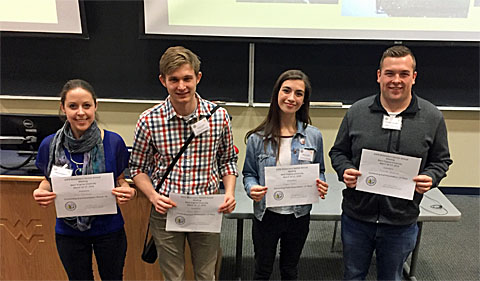
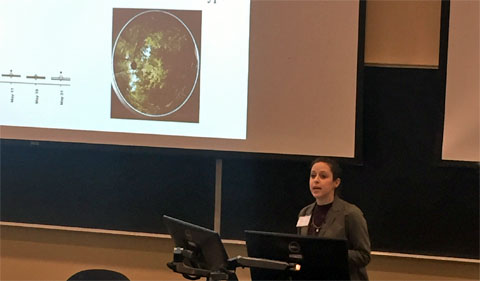
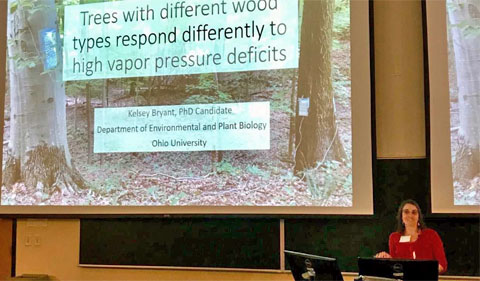
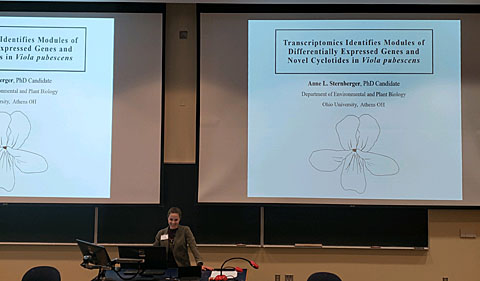
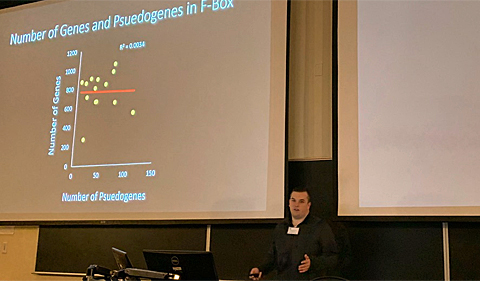
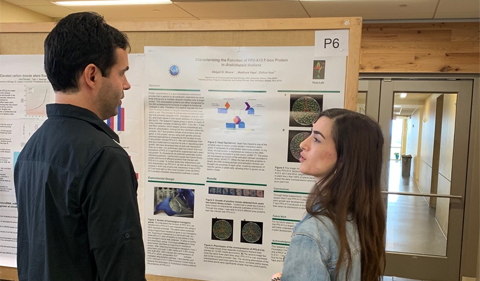
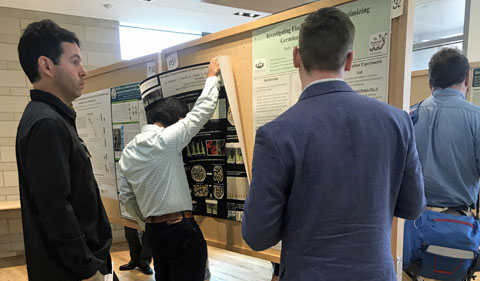
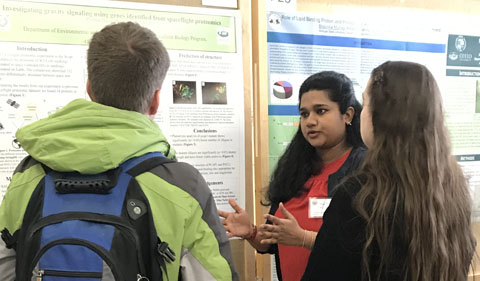
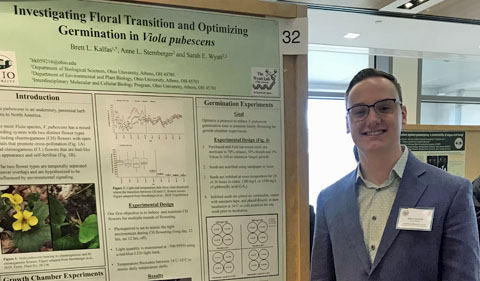
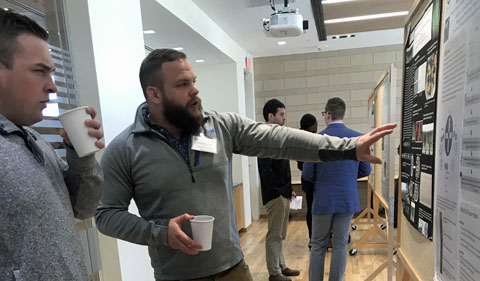
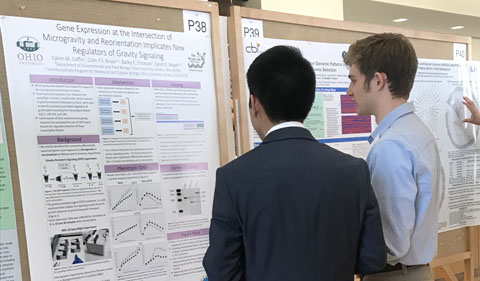

















Comments